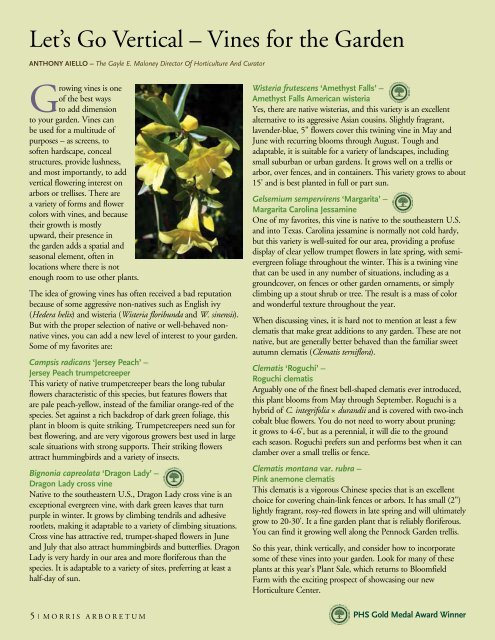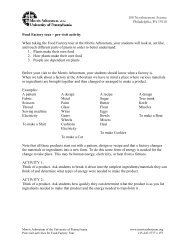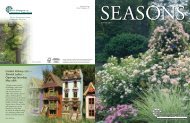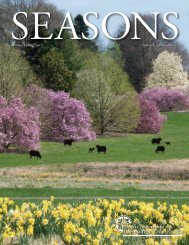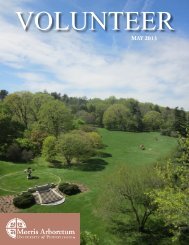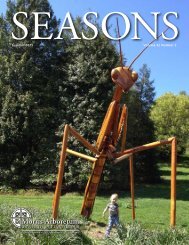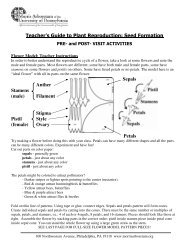2010 - Business Services - University of Pennsylvania
2010 - Business Services - University of Pennsylvania
2010 - Business Services - University of Pennsylvania
You also want an ePaper? Increase the reach of your titles
YUMPU automatically turns print PDFs into web optimized ePapers that Google loves.
Let’s Go Vertical – Vines for the Garden<br />
aNTHONy aIellO – The Gayle E. Maloney Director Of Horticulture And Curator<br />
Growing vines is one<br />
<strong>of</strong> the best ways<br />
to add dimension<br />
to your garden. Vines can<br />
be used for a multitude <strong>of</strong><br />
purposes – as screens, to<br />
s<strong>of</strong>ten hardscape, conceal<br />
structures, provide lushness,<br />
and most importantly, to add<br />
vertical flowering interest on<br />
arbors or trellises. There are<br />
a variety <strong>of</strong> forms and flower<br />
colors with vines, and because<br />
their growth is mostly<br />
upward, their presence in<br />
the garden adds a spatial and<br />
seasonal element, <strong>of</strong>ten in<br />
locations where there is not<br />
enough room to use other plants.<br />
The idea <strong>of</strong> growing vines has <strong>of</strong>ten received a bad reputation<br />
because <strong>of</strong> some aggressive non-natives such as English ivy<br />
(Hedera helix) and wisteria (Wisteria floribunda and W. sinensis).<br />
But with the proper selection <strong>of</strong> native or well-behaved nonnative<br />
vines, you can add a new level <strong>of</strong> interest to your garden.<br />
Some <strong>of</strong> my favorites are:<br />
Campsis radicans ‘Jersey Peach’ –<br />
Jersey Peach trumpetcreeper<br />
This variety <strong>of</strong> native trumpetcreeper bears the long tubular<br />
flowers characteristic <strong>of</strong> this species, but features flowers that<br />
are pale peach-yellow, instead <strong>of</strong> the familiar orange-red <strong>of</strong> the<br />
species. Set against a rich backdrop <strong>of</strong> dark green foliage, this<br />
plant in bloom is quite striking. Trumpetcreepers need sun for<br />
best flowering, and are very vigorous growers best used in large<br />
scale situations with strong supports. Their striking flowers<br />
attract hummingbirds and a variety <strong>of</strong> insects.<br />
Bignonia capreolata ‘Dragon lady’ –<br />
Dragon lady cross vine<br />
Native to the southeastern U.S., Dragon Lady cross vine is an<br />
exceptional evergreen vine, with dark green leaves that turn<br />
purple in winter. It grows by climbing tendrils and adhesive<br />
rootlets, making it adaptable to a variety <strong>of</strong> climbing situations.<br />
Cross vine has attractive red, trumpet-shaped flowers in June<br />
and July that also attract hummingbirds and butterflies. Dragon<br />
Lady is very hardy in our area and more floriferous than the<br />
species. It is adaptable to a variety <strong>of</strong> sites, preferring at least a<br />
half-day <strong>of</strong> sun.<br />
5 | M O r r I S A r B O r E T U M<br />
Wisteria frutescens ‘amethyst Falls’ –<br />
amethyst Falls american wisteria<br />
Yes, there are native wisterias, and this variety is an excellent<br />
alternative to its aggressive Asian cousins. Slightly fragrant,<br />
lavender-blue, 5" flowers cover this twining vine in May and<br />
June with recurring blooms through August. Tough and<br />
adaptable, it is suitable for a variety <strong>of</strong> landscapes, including<br />
small suburban or urban gardens. It grows well on a trellis or<br />
arbor, over fences, and in containers. This variety grows to about<br />
15' and is best planted in full or part sun.<br />
Gelsemium sempervirens ‘Margarita’ –<br />
Margarita Carolina Jessamine<br />
One <strong>of</strong> my favorites, this vine is native to the southeastern U.S.<br />
and into Texas. Carolina jessamine is normally not cold hardy,<br />
but this variety is well-suited for our area, providing a pr<strong>of</strong>use<br />
display <strong>of</strong> clear yellow trumpet flowers in late spring, with semievergreen<br />
foliage throughout the winter. This is a twining vine<br />
that can be used in any number <strong>of</strong> situations, including as a<br />
groundcover, on fences or other garden ornaments, or simply<br />
climbing up a stout shrub or tree. The result is a mass <strong>of</strong> color<br />
and wonderful texture throughout the year.<br />
When discussing vines, it is hard not to mention at least a few<br />
clematis that make great additions to any garden. These are not<br />
native, but are generally better behaved than the familiar sweet<br />
autumn clematis (Clematis terniflora).<br />
Clematis ‘roguchi’ –<br />
roguchi clematis<br />
Arguably one <strong>of</strong> the finest bell-shaped clematis ever introduced,<br />
this plant blooms from May through September. roguchi is a<br />
hybrid <strong>of</strong> C. integrifolia × durandii and is covered with two-inch<br />
cobalt blue flowers. You do not need to worry about pruning:<br />
it grows to 4-6', but as a perennial, it will die to the ground<br />
each season. roguchi prefers sun and performs best when it can<br />
clamber over a small trellis or fence.<br />
Clematis montana var. rubra –<br />
Pink anemone clematis<br />
This clematis is a vigorous Chinese species that is an excellent<br />
choice for covering chain-link fences or arbors. It has small (2")<br />
lightly fragrant, rosy-red flowers in late spring and will ultimately<br />
grow to 20-30'. It a fine garden plant that is reliably floriferous.<br />
You can find it growing well along the Pennock Garden trellis.<br />
So this year, think vertically, and consider how to incorporate<br />
some <strong>of</strong> these vines into your garden. Look for many <strong>of</strong> these<br />
plants at this year’s Plant Sale, which returns to Bloomfield<br />
Farm with the exciting prospect <strong>of</strong> showcasing our new<br />
Horticulture Center.<br />
PHS Gold Medal award Winner


